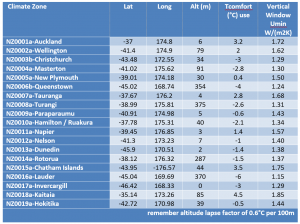Thermal comfort targets have been revised by the Passive House Institute for use in PHPP.
Passive House certification requires that windows and doors meet specified thermal comfort targets*. This requirement ensures people inside Passive Houses will enjoy comfortable temperatures everywhere, even if sitting right next to a window in the middle of winter.
I became aware some time back that the assumptions underpinning the thermal comfort calculations in PHPP were too stringent in two specific locations. I argued the case for revision and while it took rather a long time for PHI to look into this, it has now updated the requirements for Wellington and Queenstown.
Please make note of the table below, as I’m not aware that the revised information has been published elsewhere yet. This came into effect on 9 October 2019.

Thermal comfort criteria for windows in PHPP are dependent on:
- the installation PSI value,
- U-value for the frame and the frame width,
- glazing edge PSI value and
- the U-value for the glass.
These are all shown in the table for clarity.
As windows get larger, the U-value for the glass dominates, but installation and frame values are very important for smaller windows. The rightmost column in the graph for the ‘Vertical Window U-value minimum’ shows the lowest permissible value for each New Zealand climate zone, at the altitude of the weather station.
The biggest implication is that it is possible, with very good frames and installation details, to use double glazing in all the New Zealand climate zones—at least in terms of the thermal comfort requirement. A large building in a colder climate must still meet the heating demand or load requirement but this change opens up interesting possibilities for a hotel in Queenstown or an apartment building in Wellington.
More geeky details for those inclined: the PHPP software uses a window external thermal comfort temperature to check the thermal comfort criteria. This is the minimum 12-hour rolling average for a typical year. In general, in New Zealand, we’ve used the NIWA EPW (Energy Plus) typical or reference years for determining this.
Remember that PHPP adjusts temperatures for altitude. For example, if your weather station is at 2 metres and your building site is at 102 metres, you would use a temperature 0.6˚C lower. For Dunedin, if you’re building 100 metres above the weather station altitude, the relevant temperature drops to -2.0˚C (from -1.4˚C).
Most of this country is in a warm-temperate climate zone. Queenstown, Lauder and Invercargill are cool-temperate and Kaitaia, Auckland, New Plymouth, Tauranga and Napier are warm climate (at the weather station altitude). Note this well, because each climate zone has to meet different moisture protection requirements (fRSI).
Note that thermal comfort criteria do not apply to the PHI Low Energy Building certification. The moisture protection requirements, however, do apply to LEBs.
* NB There are a few exceptions, including:
- those that will not impact thermal comfort (eg clearstories or an entrance door),
- small openings (less than 1 sqm), and /or
- isolated openings, so that in combination with surrounding surfaces thermal comfort would likely be met.
—Jason Quinn
Revised 17 June 2020